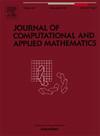具有两种不同导数的分数阶微分方程解的振荡行为
IF 2.6
2区 数学
Q1 MATHEMATICS, APPLIED
Journal of Computational and Applied Mathematics
Pub Date : 2025-09-25
DOI:10.1016/j.cam.2025.117098
引用次数: 0
摘要
本文研究了一类强迫非线性分数阶微分方程(FDEs)解的渐近性和振荡性,该方程具有两个不同的Caputo分数阶导数,形式为CDcαZ(r)+aCDcβZ(r)−g1(r,Z(r))=e(r)+g2(r,Z(r)),c>1,其中0<;β<1<1+β≤α<2。虽然已知多项fde可以有效地模拟复杂的多尺度现象,如粘弹性,但导数跨越次扩散(β<1)和超扩散(α>1)的方程的定性理论仍然不发达。这项研究旨在弥合这一差距。在非线性函数g1和g2的特定生长条件下,建立了新的充分判据,保证方程的所有解都是振荡的。该证明技术采用统一的框架,将整数阶微积分的半群性质与分数算子相结合,并通过假设非振荡解的存在性和推导矛盾来进行反事实论证。本文的结果极大地推广了已有的多导数分数阶微分方程的振荡理论。通过实例进一步说明了理论结果。本文章由计算机程序翻译,如有差异,请以英文原文为准。
Oscillatory behavior of solutions of fractional differential equations with two different derivatives
This study investigates the asymptotic and oscillatory behavior of solutions to a class of forced nonlinear fractional differential equations (FDEs) characterized by two distinct Caputo fractional derivatives of the form where . While multi-term FDEs are known to effectively model complex multi-scale phenomena like viscoelasticity, the qualitative theory for equations where the derivatives span both the sub-diffusive () and super-diffusive () regimes remains underdeveloped. This study aims to bridge this gap. Under specific growth conditions on the nonlinear functions and , novel sufficient criteria are established to ensure that all solutions of the equation are oscillatory. The proof technique employs a unified framework integrating the semi-group properties of integer-order calculus with fractional operators and proceeds via a counterfactual argument by assuming the existence of a non-oscillatory solution and deriving a contradiction. The results presented here significantly extend the existing oscillation theory for fractional differential equations with multiple derivatives. The theoretical findings are further illustrated with some examples.
求助全文
通过发布文献求助,成功后即可免费获取论文全文。
去求助
来源期刊
CiteScore
5.40
自引率
4.20%
发文量
437
审稿时长
3.0 months
期刊介绍:
The Journal of Computational and Applied Mathematics publishes original papers of high scientific value in all areas of computational and applied mathematics. The main interest of the Journal is in papers that describe and analyze new computational techniques for solving scientific or engineering problems. Also the improved analysis, including the effectiveness and applicability, of existing methods and algorithms is of importance. The computational efficiency (e.g. the convergence, stability, accuracy, ...) should be proved and illustrated by nontrivial numerical examples. Papers describing only variants of existing methods, without adding significant new computational properties are not of interest.
The audience consists of: applied mathematicians, numerical analysts, computational scientists and engineers.

 求助内容:
求助内容: 应助结果提醒方式:
应助结果提醒方式:


